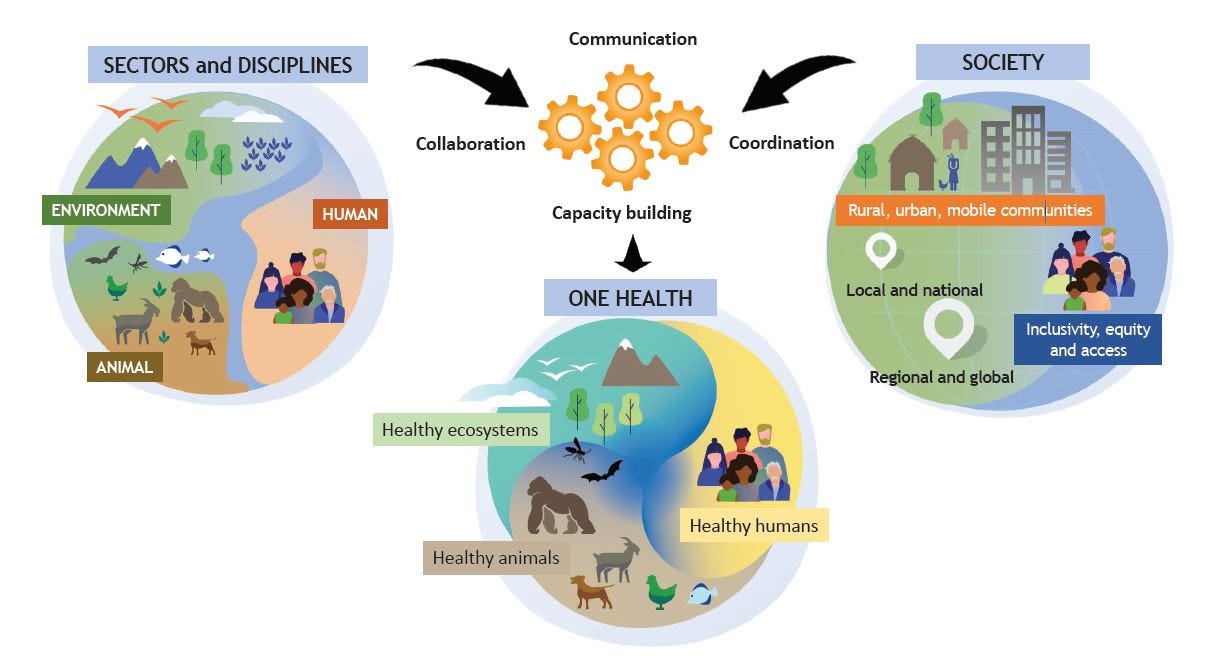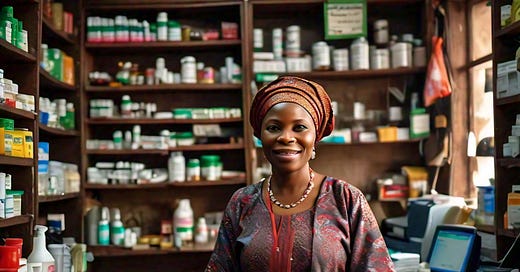FROM ‘MIRACLE MEDS’ TO MAYHEM: COMBATING ANTIMICROBIAL RESISTANCE.
AIM:
This article tells a very relatable story that exposes the harsh reality of Antimicrobial Resistance (AMR) in our communities. Through everyday characters and scenarios, it reveals how our daily choices unknowingly fuel the AMR crisis. It also seeks to help you explore the human side of AMR and discover how we can all play a part in fighting this growing threat.
GIVEN:
Antimicrobial Resistance, awareness, one health, symptoms, causes, solutions.
METHOD:
Storytelling
PRINCIPLE:
Antimicrobial Resistance (AMR) is a ticking time bomb, fueled by the misuse and overuse of antibiotics. Here's how it works: when antibiotics are used, they unleash a selective pressure that kills off susceptible bacteria, leaving behind superbugs to multiply, spread, and share their resistant genes with other bacteria, creating an army of untreatable infections. Basically, it's a game of survival - the strongest bacteria win, and we lose. While what the microbes do might be hidden to us, what we do to enhance this process is usually staring us in the face while we pay little attention as evident in the story below.
Everyone in Umukoro town knew Aunty Ejiro, popularly known as Mamooo. Her larger than life personality is in sharp contrast to her small size and there was never going to be a dull time with her. Her thick black hair, streaked with grey, was always neatly braided into four cornrows. Before the Gen Zs of this world adopted Bubu gowns, it had been Mamooo’s signature attire which perfectly suited her petite frame. As a local midwife and entrepreneur, her shop was the community's go-to for baby deliveries, medications, and unsolicited advice. With her thick Warri accent and friendly smile, Mamooo often shared her two cents on everything from healthcare to relationships. She ensured customers left the store with a healthy dose of her opinions for free.
One day, Mamooo's son, Tega, returned home after national youth service but Mamooo couldn’t believe her eyes. Tega’s gaunt frame and sun-scorched skin sent his mother into a frenzy. His eyes, once bright and full of life, now seemed dull and sunken. She immediately provided him with her 'miracle meds': anti-malaria, amoxicillin, and multivitamins. With a knowing glint in her eye, she declared, “Nah those giant mosquitoes wey dey that camp wan suck my pikin blood dry, na why he con resemble toothpick!”
Weeks passed, and Tega's condition worsened. He suffered from persistent fatigue, headaches, and fever. Confident in her medical prowess, Mamooo dished out more anti-malaria, ampicillin, and amoxicillin tablets. After all, she’s seen several customers with similar symptoms getting back on her feet after using her drug combo, she assured him, “Take dis ones sharp sharp, my son. You go dey kampe!”
But Tega’s condition didn’t improve. He passed out one morning and was rushed to the hospital beside the barracks, where Mammo once lived. Thanks to her fame, he was quickly attended to.
At the hospital, Dr. Kajo, a young, soft-spoken, bespectacled physician, met Mammo at Tega's bedside. He revealed that Tega's results from the lab showed an antibiotic-resistant bacteria is responsible for the ailment. He then explained the harm of antibiotic misuse to her. Mamooo's eyes widened as realisation dawned, “Ogheneme! I for use my own hand kill my own pikin!” She humbly acknowledged how she and her chemist shop had unknowingly contributed to Antimicrobial Resistance (AMR). Regrettably, her son was her first known victim.
As Dr. Kajo continued, a woman entered the ward, her worried eyes scanning the room. Mammo recognized her - she was Aisha, Musa's wife. As usual, Mamooo’s mother-hen instincts kicked in. She started pondering what could have brought Aisha here. As if in response, Musa, the community's beloved suya seller, who lay a few beds away from Tega left out a grunt as he rolled to his left side. He was battling a stubborn urinary tract infection caused by resistant E. Coli.

Dr. Kajo explained that Musa had admitted to stopping antibiotic treatment as soon as symptoms subsided, never completing the full dosage. This alarming habit, coupled with Mammo's well-intentioned but misguided prescription had fueled the development of resistant bacteria in Musa’s body.
As Mamoo scanned around in shock, another patient, Amaka, caught her attention. After a little proding, Mamooo discovered she was also fighting a resistant microbe too. A chilling connection dawned on Mammo: Amaka frequently bought antibiotics from her store for her farm, and Musa's suya stand was a hotspot for community gatherings. The contaminated water, infused with resistant bacteria, had been distributed throughout the community via Musa's suya. Amaka, who handled contaminated poultry and water, had unknowingly carried the resistant bacteria into her own body, falling victim to the similar resistant bacteria that now threatened Tega and Musa.
PROCEDURE:
Mamooo's fictional story—a personal, yet relatable one—sheds light on the complex web of factors contributing to Antibiotic Resistance (AMR). A closer look at the characters' lives reveals the interconnected causes:
Self-medication and misuse: Mamooo's well-intentioned but misguided prescribing of antibiotics to Tega exemplifies the dangers of self-medication and misuse.
Incomplete treatment: Musa's decision to stop taking antibiotics when symptoms subsided allowed resistant bacteria to thrive.
Contaminated food and water: Amaka's poultry farm polluted the water supply, while Musa's suya stand unknowingly contributed to contaminated food.
Poor hygiene practices: This is seen in Amaka and Musa by the virtue of not handling food items properly.
Lack of awareness and education: The community's limited understanding of AMR and its risks perpetuates the problem.
Additionally, other factors not covered in the story can contribute to AMR and some of them include:
Systemic factors: Inadequate healthcare infrastructure, insufficient training, poor waste management and water pollution contribute to AMR's spread.
Natural/genetic changes: Bacteria, particularly, can mutate rapidly, and acquire genes that confer resistance to antibiotics. Combining this with overuse of these drugs, will accelerate this evolutionary process and thereby create 'superbugs' that are immune to standard treatments.
Lack of new antimicrobial development: The process of developing antibiotics is usually long and expensive. This cost can be as high as $1.5 billion and the development of alternatives such as phage therapy is experiencing slow adoption while probiotics have shown mixed results.
RECOMMENDATION:
Fortunately, the fight against AMR is not hopeless. To combat AMR public health agencies have recommended 'The One Health approach'. According to the World Health Organization (WHO), One Health is an integrated, unifying approach that aims to sustainably balance and optimise the health of people, animals and ecosystems. It recognizes that the health of humans, animals, and the wider environment are inherently linked and interdependent.
The relevance of this approach is evident In Mamooo's community and it can be practically applied to create effective solutions to AMR:
On Human Health:
Adopting responsible antibiotic prescribing practices in Mamooo's chemist store will save the community.
Prioritizing proper hand hygiene and infection control at the hospital by Dr. Kajo and other staff.
Enhanced training for healthcare professionals, like Dr. Kajo and scientists in the lab on AMR and antibiotic stewardship.
Carrying out Community awareness campaigns, led by healthcare professionals and Mamooo to educate residents on AMR risks and prevention will tackle misuse and abuse. Training programmes and education on One Health principles will empower community members to take ownership of AMR prevention.
Establishing a One Health task force led by Mamooo and Dr. Kajo in the community will facilitate effective coordination in the fight against (AMR).
Knowledge Sharing: Collaborating with neighboring communities to share best practices, lessons learned, and successful strategies will amplify the impact against AMR.
On Animal Health:
Transitioning to sustainable agricultural practices to reduce antibiotic use in Amaka’s poultry farm is a great way to begin. Alternative growth promoters, such as vaccines and probiotics, can replace the use of antibiotics on the animals.
Musa's suya stand can then source meat from the farm, supporting antibiotic-free livestock.
Ensuring Biosafety measures are put in place will prevent disease spread to farm workers like Amaka.
On Environmental Health:
Improving waste management and water quality around Musa's suya stand and the poultry farm will reduce AMR spread
Sustainable agricultural practices minimizing antibiotic residues in soil and water
Implementing climate change mitigation strategies that address AMR's environmental dimensions.

Other possible solutions:
Support Research and Development: Encouraging innovation in antimicrobial development, diagnostic tools, and vaccines will help stay ahead of resistant bacteria. Providing grants and scholarships can fuel research in tertiary institutions, fostering a new generation of scientists dedicated to tackling AMR.
Simultaneously, lawmakers must strengthen and enforce regulations surrounding the sale and distribution of antimicrobials, by passing favourable bills in this regard. There should be a ban on the sales of medication by non-licensed individuals, by the roadside and in transportation vehicles.
Pharmaceutical companies and Government agencies such as the National Agency for Food Drug Administration Control (NAFDAC) need to collaborate to innovate and discover new antimicrobial drugs to replace those that have become ineffective. Leveraging government support, private sector partnerships, and international cooperation will provide necessary resources for education, research, and infrastructure development. Nigeria is currently moving in the right direction with the launch of One Health Antimicrobial Resistance National Action Plan 2.0 in October
By adopting this comprehensive approach, Mamooo's community will become a model for effective AMR mitigation, improving public health and contributing to a safer, healthier environment.
COMMENTS:
The war against Antimicrobial Resistance is not impossible to win. However, it demands an army of advocates – from street vendors to healthcare professionals, every individual has a crucial role to play. Awareness is our first line of defense, but a united front that combines human, animal, and environmental health will unleash our greatest strength. Together, we can triumph over AMR – one informed choice, one responsible action, and one collective effort at a time.
Pikin: ‘Child’ in pidgin English
Oghenemeh: A phrase mostly used to express surprise, meaning ‘My God’, in Urhrobo, a Nigerian indigenous language.








